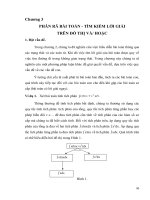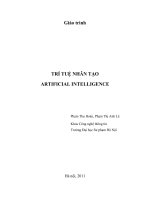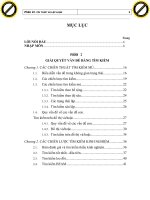Slide trí tuệ nhân tạo neural network
Bạn đang xem bản rút gọn của tài liệu. Xem và tải ngay bản đầy đủ của tài liệu tại đây (749.83 KB, 31 trang )
Introduction to
Artificial Intelligence
Chapter 4: Learning (2)
Artificial Neural Network A Brief Overview
Nguyễn Hải Minh, Ph.D
CuuDuongThanCong.com
/>
Outlines
❑Biological Inspiration.
❑Artificial Neural Networks.
❑ANN Architectures.
❑Learning Processes.
❑ANN Capabilities & Limitations
8/7/2017
Nguyễn Hải Minh @ FIT - HCMUS
CuuDuongThanCong.com
2
/>
Biological Inspiration
Some numbers…
➢ The human brain contains about 10 billion
nerve cells (neurons).
➢Each neuron is connected to the others through
10000 synapses.
Properties of the brain:
➢ It can learn, reorganize itself from experience.
➢ It adapts to the environment.
8/7/2017
Nguyễn Hải Minh @ FIT - HCMUS
CuuDuongThanCong.com
3
/>
The Neuron in Real Life
The information transmission
happens at the synapses.
➢ The neuron receives nerve impulses through its dendrites.
➢ It then sends the nerve impulses through its axon to the terminals
where neurotransmitters are released to stimulate other neurons.
8/7/2017
Nguyễn Hải Minh @ FIT - HCMUS
CuuDuongThanCong.com
4
/>
Model Of A Neuron
X1
X2
X3
Wa
Wb
f()
Y
Wc
Input units
Connection
weights
(dendrite)
(synapse)
Summing
function
computation
(axon)
(soma)
8/7/2017
Nguyễn Hải Minh @ FIT - HCMUS
CuuDuongThanCong.com
5
/>
Artificial Neuron
❑Definition: Neuron is the basic information
processing unit of the Neural Networks (NN). It is
a non linear, parameterized function with
restricted output range.
8/7/2017
Nguyễn Hải Minh @ FIT - HCMUS
CuuDuongThanCong.com
6
/>
Artificial Neural Networks
➢Artificial Neural Network (ANN): is a machine learning
approach that models human brain and consists of a
number of artificial neurons that are linked together
according to a specific network architecture.
➢Neuron in ANNs tend to have fewer connections than
biological neurons. each neuron in ANN receives a number
of inputs.
➢An activation function is applied to these inputs which
results in activation level of neuron (output value of the
neuron).
➢Knowledge about the learning task is given in the form of
examples called training examples.
8/7/2017
Nguyễn Hải Minh @ FIT - HCMUS
CuuDuongThanCong.com
7
/>
Applications of ANN
Some tasks to be solved by Artificial Neural Networks:
❖ Classification: Linear, non-linear.
❖ Recognition: Spoken words, Handwriting. Also
recognizing a visual object: Face recognition.
❖ Controlling: Movements of a robot based on self
perception and other information.
❖ Predicting: Where a moving object goes, when a
robot wants to catch it.
❖ Optimization: Find the shortest path for the TSP.
8/7/2017
Nguyễn Hải Minh @ FIT - HCMUS
CuuDuongThanCong.com
8
/>
Artificial Neural Networks
❑Before using ANN, we have to define:
1. Artificial Neuron Model.
2. ANN Architecture.
3. Learning Mode.
8/7/2017
Nguyễn Hải Minh @ FIT - HCMUS
CuuDuongThanCong.com
9
/>
Computing with Neural Units
❑Incoming signals to a unit are presented as
inputs.
❑How do we generate outputs?
• One idea: Summed Weighted
Inputs.
• Input: (3, 1, 0, -2)
• Processing
3(0.3) + 1(-0.1) + 0(2.1) + -2(-1.1)
= 0.9 + (-0.1) + 0 + 2.2
• Output: 3
8/7/2017
Nguyễn Hải Minh @ FIT - HCMUS
CuuDuongThanCong.com
10
/>
Activation Functions
❑Usually, do not just use weighted sum
directly.
❑Apply some function to the weighted sum
before it is used (e.g., as output).
→Activation function.
8/7/2017
Nguyễn Hải Minh @ FIT - HCMUS
CuuDuongThanCong.com
11
/>
Activation Functions
▪ The choice of activation function determines the Neuron Model.
8/7/2017
Nguyễn Hải Minh @ FIT - HCMUS
CuuDuongThanCong.com
12
/>
Bias of a Neuron
❑Bias is like another weight. It’s included
by adding a component x0=1 to the input
vector X.
❑X=(1,X1,X2…Xi,…Xn)
❑Bias is of two types
o Positive bias: increase the net input
o Negative bias: decrease the net input
CuuDuongThanCong.com
/>
Bias of a Neuron
❑The bias b has the effect of applying a
transformation to the weighted sum u
v=u+b
❑The bias is an external parameter of the neuron.
It can be modeled by adding an extra input.
❑v is called induced field of the neuron:
8/7/2017
Nguyễn Hải Minh @ FIT - HCMUS
CuuDuongThanCong.com
14
/>
Learning rate
❑Denoted by α.
❑Used to control the amount of weight
adjustment at each step of training
❑E.g. Perceptron rule:
wi wi + α(y – hw(X))*xi
❑Learning rate ranging from 0 to 1
determines the rate of learning in each
time step
CuuDuongThanCong.com
/>
Example (1): Step Function
8/7/2017
Nguyễn Hải Minh @ FIT - HCMUS
CuuDuongThanCong.com
16
/>
Example (2): Another Step
Function
8/7/2017
Nguyễn Hải Minh @ FIT - HCMUS
CuuDuongThanCong.com
17
/>
Example (3): Sigmoid Function
➢ The math of some neural nets requires that the
activation function be continuously
differentiable.
→ A sigmoidal function often used to approximate
the step function.
8/7/2017
Nguyễn Hải Minh @ FIT - HCMUS
CuuDuongThanCong.com
18
/>
Example (3): Sigmoid Function
8/7/2017
Nguyễn Hải Minh @ FIT - HCMUS
CuuDuongThanCong.com
19
/>
Example
❑Calculate the output from the neuron below assuming a
threshold of 0.5:
o Sum = (0.1 x 0.5) + (0.5 x 0.2) + (0.3 x 0.1) = 0.05 + 0.1
+ 0.03 = 0.18
o Since 0.18 is less than the threshold, the Output = 0
o Repeat the above calculation assuming that the
neuron has a sigmoid output function:
8/7/2017
Nguyễn Hải Minh @ FIT - HCMUS
CuuDuongThanCong.com
20
/>
Network Architecture
❑The Architecture of a neural network is linked
with the learning algorithm used to train.
❑There are different classes of network
architecture:
o Single-Layer Neural Networks.
o Multi-Layer Neural Networks.
o→ The number of layers and neurons depend on
the specific task.
8/7/2017
Nguyễn Hải Minh @ FIT - HCMUS
CuuDuongThanCong.com
21
/>
Single Layer Neural Network
❑Another name: Perceptron
o A network with all inputs connected directly to the
output.
o m outputs = m separate training processes
o Learning rule: Perceptron learning rule or gradient
descent rule
✓ Unit 3: the carry function
✓ Unit 4: the sum function
8/7/2017
A perceptron network with
2 inputs and 2 outputs
Nguyễn Hải Minh @ FIT - HCMUS
CuuDuongThanCong.com
22
/>
Single Layer Neural Network
x1 AND x2
x1 XOR x2
Unit 3 learns the
carry function easily
Unit 4 fails to learn
the sum function
→ Perceptron cannot learn a non-linearly separable function
8/7/2017
Nguyễn Hải Minh @ FIT - HCMUS
CuuDuongThanCong.com
23
/>
Perceptron vs Decision Trees
WillWait function
Majority function
→ Perceptron can represent some quite “complex” Boolean
functions very compactly.
8/7/2017
Nguyễn Hải Minh @ FIT - HCMUS
CuuDuongThanCong.com
24
/>
Multi Layer Neural Network
A multi layer network with 2 inputs, 2 hidden units, and 2 outputs
➢ More general network architecture, where there are hidden
layers between input and output layers.
➢ Hidden nodes do not directly receive inputs nor send outputs
to the external environment.
➢ Multi Layer NN overcome the limitation of Single-Layer NN,
they can handle non-linearly separable learning tasks.
➢ Learning algorithm: Back-Propagation
8/7/2017
Nguyễn Hải Minh @ FIT - HCMUS
CuuDuongThanCong.com
25
/>









